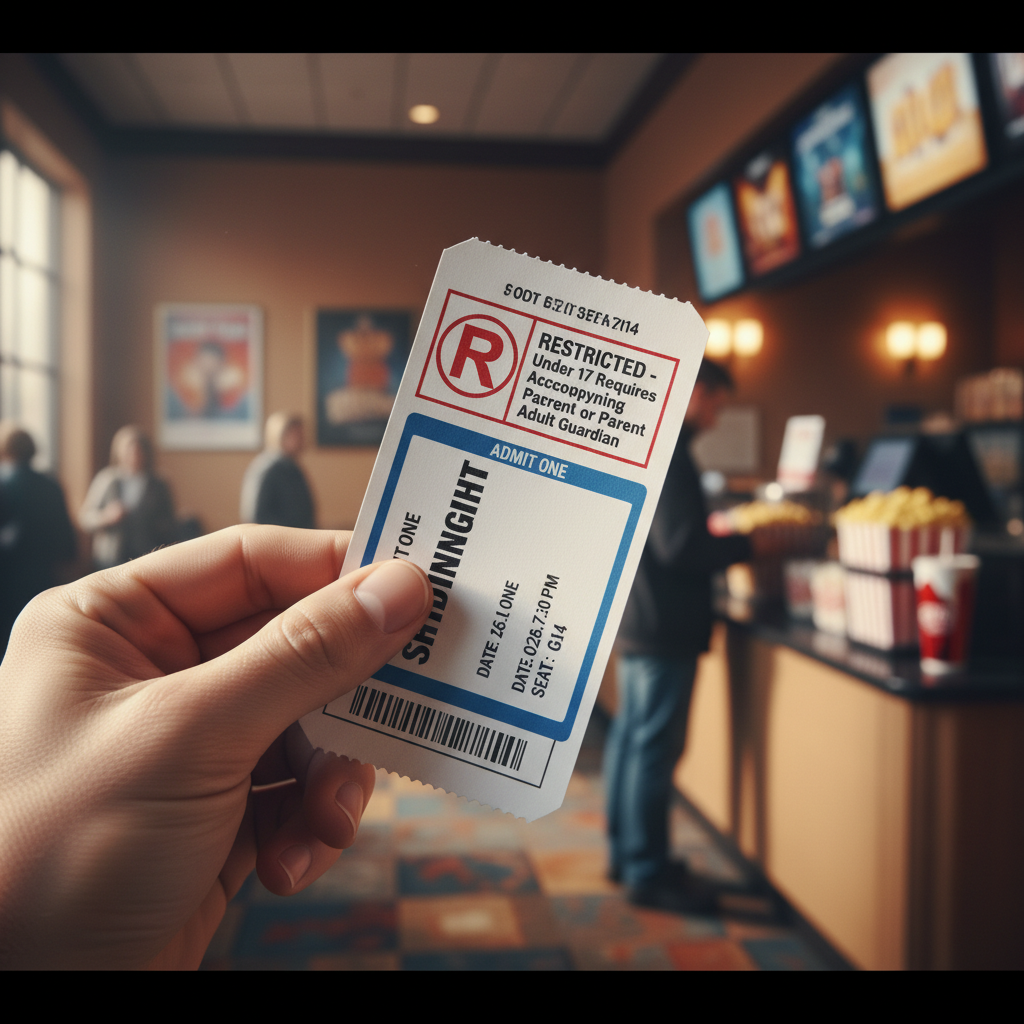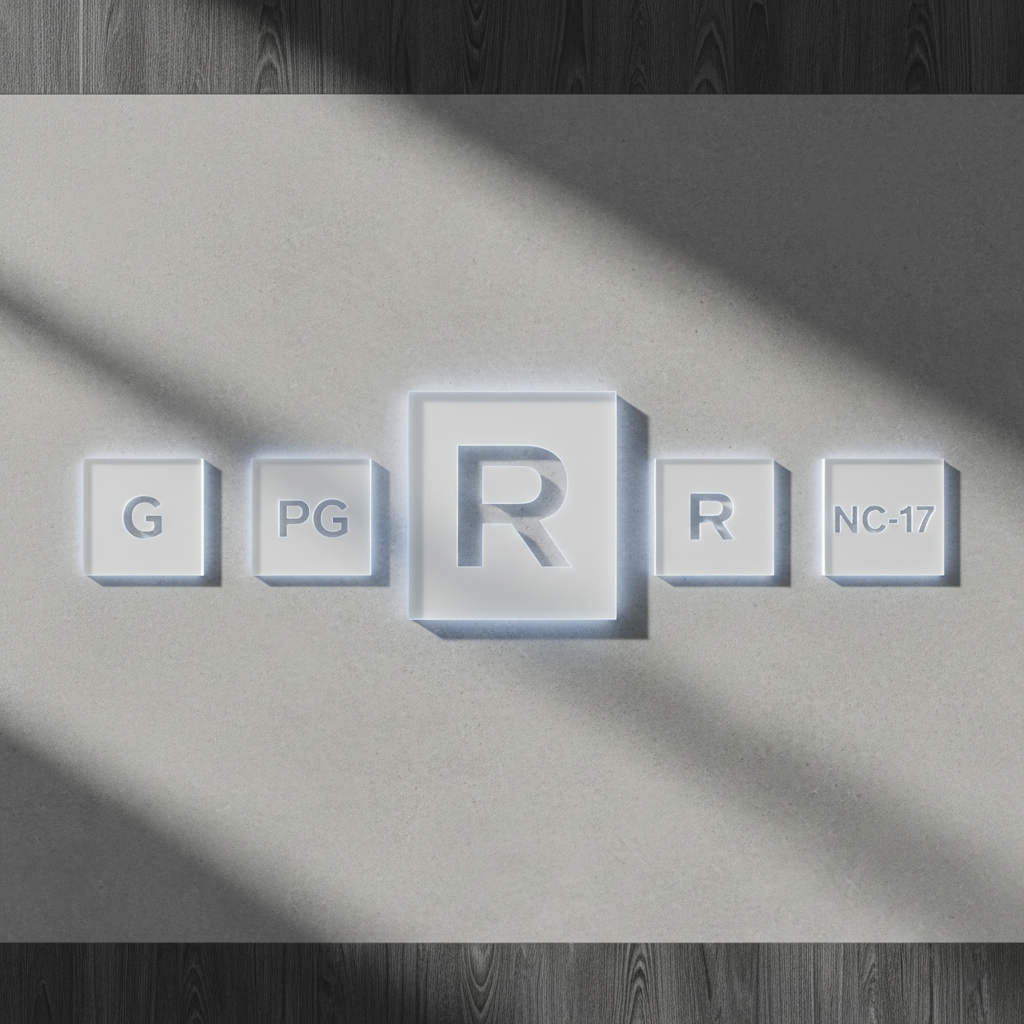An R rating, which stands for Restricted, is a film rating designated by the Motion Picture Association (MPA). It signifies that a film contains adult material and that viewers under 17 require an accompanying parent or adult guardian to see it in a theater. This rating is typically assigned to movies with harsh language, intense violence, drug abuse, or sexual content.
Have you ever been excited to see a new blockbuster, only to be stopped by the mysterious “R” on the poster? Or maybe you’ve scrolled through streaming services, wondering why some films are marked R Rated while others are not. This is a common experience for all movie lovers, from casual viewers to dedicated cinephiles. Understanding these ratings is more than just following rules—it’s about knowing what content to expect and navigating the world of cinema with confidence.
Here at IWatchMovies Blog, we’re diving deep into one of the most talked-about classifications: the R Rated movie. This guide will explain exactly what the ‘Restricted’ label means, what kind of content typically earns this rating, and the specific age requirements for viewing. We’ll also clarify if a 17-year-old can see an R-rated film, compare it to other ratings like PG-13 and NC-17, and look at classic examples that helped define the category.
So, if you’ve ever felt confused by the Motion Picture Association’s (MPA) system or just want to become an expert on film classifications, you’ve come to the right place. Let’s start by defining what it really means for a movie to be R Rated.
What is the meaning of r-rated?

The ‘Restricted’ Label Explained
When you see the R rating next to a movie title, it means one thing: Restricted. This is not a suggestion but an official classification from the MPA (Motion Picture Association). The goal of the MPA film rating system is to give parents advance information about a movie’s content. [1]
For moviegoers, “restricted” means that anyone under 17 is not allowed to see an R-rated movie unless they are with a parent or adult guardian. The guardian must be at least 21 years old. This rule is designed to give parents the final say on whether specific content is appropriate for their children.
The R rating indicates that a film contains material—such as strong language, violence, nudity, or drug use—that may be too intense for younger viewers. Because the MPA believes parents are the best judges for their own families, the system empowers them by restricting access for unaccompanied minors.
Common Elements in R-Rated Films
An R rating is not assigned lightly. A film typically earns this rating when it features content considered disturbing or inappropriate for younger audiences. Usually, it’s a combination of the following elements that pushes a movie into this category:
- Strong Language: Films with frequent or intense profanity, including multiple uses of expletives, are often rated R. This is common in gritty dramas or action movies that aim for realism.
- Graphic Violence: This includes explicit portrayals of combat, gore, torture, or other intense violent acts. Movies like John Wick or many horror films often fall into this category due to their impactful violence.
- Sexual Content: Full nudity, explicit sexual situations, strong sexual dialogue, or pervasive sexual themes can all contribute to an R rating. This content is often direct and visual, not just suggestive.
- Drug Use: Explicit depictions of illegal drug use, substance abuse, or excessive alcohol consumption can also earn an R rating. These scenes are often portrayed realistically, showing the consequences or illicit nature of the activity.
- Mature Themes: Some films receive an R rating for exploring dark, disturbing, or complex psychological themes that are unsuitable for children. This can include topics like extreme trauma, severe mental health struggles, or morally ambiguous narratives.
It’s important to remember that the MPA considers the overall context and intensity of these elements. A single swear word might not warrant an R, but a constant barrage combined with graphic violence certainly could. The rating is based on the cumulative impact on the viewer.
Can a 17 year old go see a rated R movie?

Understanding the ‘Accompanying Guardian’ Rule
The R rating for movies includes a specific rule for viewers under 17 years old. To ensure parental guidance for mature themes, anyone under 17 is not permitted to buy a ticket to an R-rated movie on their own.
Here are the core requirements of this rule:
- Minors under 17 years old must be accompanied by a parent or adult guardian.
- The accompanying adult must be at least 21 years old [2].
- This guardian must purchase the tickets for both themselves and the minor.
- Crucially, the guardian must stay with the minor for the entire duration of the film.
This policy reflects the intention of the MPAA (Motion Picture Association of America). The goal is to ensure parents or guardians can determine if a film’s mature content is appropriate for the children in their care. In essence, the accompanying guardian serves as the decision-maker for the minor, providing supervision rather than just a ticket.
Theater Policies and ID Checks
Most cinema chains strictly enforce R-rating rules. This process often involves ID checks to ensure compliance with MPAA guidelines and local regulations.
Here’s how theaters typically manage this:
- Age Verification: Expect staff to ask for a valid ID if a moviegoer appears to be under 17 or the accompanying guardian appears to be under 21.
- Accepted IDs: Valid forms of identification typically include a driver’s license, a state ID card, or a passport. Some theaters may accept student IDs, but it’s best to verify this beforehand.
- Varying Policies: While the official MPAA guideline requires a guardian to be 21, individual theater policies can sometimes differ. It is rare, but some locations might have their own specific rules.
- Checking Ahead: The best approach is to check your local cinema’s website for its specific R-rated movie policy before you go.
- Staff Discretion: Ultimately, theater management has the final say and can deny admission if they believe the rules are not being met.
To ensure a smooth moviegoing experience, it’s vital to follow these policies. Arriving prepared with a valid ID can prevent the frustration of being denied entry at the box office.
How Does an R Rating Compare to Others?

R-Rated vs. PG-13: Where’s the Line?
The jump from a PG-13 to an R rating can seem subtle, but it marks a significant divide in content. Although both ratings target older audiences, the line between them is defined by the intensity and frequency of certain elements, including language, violence, sexual content, and drug use.
While a PG-13 film might touch on mature themes, it presents them with less explicit detail. An R-rated film, in contrast, handles them more directly. Here’s how the line is drawn:
- Language: A single, non-sexual use of the “f-word” might pass in a PG-13 film. However, multiple uses or profanity in a sexual context will almost always result in an R rating.
- Violence: PG-13 allows for intense sequences of violence, but graphic depictions of gore, realistic injuries, or sustained, brutal combat typically warrant an R rating. The key difference is implied violence versus explicit bloodshed.
- Sexual Content: Brief nudity without a sexual context or strong innuendo might appear in a PG-13 movie. In contrast, any depiction of sexual activity or prolonged nudity usually results in an R rating.
- Drug Use: A PG-13 movie can show drug references or brief, non-glorified use. However, more explicit depictions, the glorification of substance abuse, or the harsh realities of addiction will lead to an R rating.
Essentially, an R rating indicates that the content is more intense and less filtered. It suggests parental guidance is not just recommended, but vital for younger viewers.
R-Rated vs. NC-17: A Key Distinction
Beyond the R rating lies a more restrictive classification: NC-17. This rating signifies a substantial jump in mature content, a critical distinction that many casual moviegoers might not fully grasp.
While R-rated films restrict viewers under 17 without a guardian, NC-17 means no one 17 or under is admitted—period. This rating is reserved for content considered explicitly adult. Though not necessarily pornographic, the material is often graphically intense.
What pushes a film from R to NC-17?
- Explicit Sexual Content: This is the most common reason. NC-17 films often feature unambiguous sexual acts that go far beyond the boundaries of an R-rated movie.
- Extreme Graphic Violence: An extreme level of violence can also lead to an NC-17 rating, especially if it is gratuitous or prolonged. This intensity surpasses what is found even in R-rated action or horror films.
- Patently Offensive Material: The MPA may issue an NC-17 rating if content is deemed “patently offensive to the average adult.” This means the material goes beyond general adult themes into a realm that many would find deeply unsettling or explicit.
Furthermore, an NC-17 rating carries a significant commercial stigma. Many theaters refuse to show these films, and major advertising platforms may decline to run ads for them. Because of this, filmmakers often recut their movies to achieve an R rating for wider distribution.
A Quick Guide to All MPA Ratings
Understanding the full spectrum of MPA ratings helps you choose the right film for any audience. Here’s a brief rundown of all the categories, from the most family-friendly to the most restricted. The Motion Picture Association (MPA) uses these ratings to provide guidance to parents [1].
| MPA Rating | Meaning | Key Characteristics |
|---|---|---|
| G | General Audiences | All ages admitted. Contains nothing that would offend parents for viewing by children. Features very mild thematic elements. |
| PG | Parental Guidance Suggested | Some material may not be suitable for young children. May contain some mild language or brief, non-graphic violence. |
| PG-13 | Parents Strongly Cautioned | Some material may be inappropriate for children under 13. Can include intense sequences of violence, some profanity, or mature thematic elements. |
| R | Restricted | Under 17 requires accompanying parent or adult guardian. Typically contains strong language, pervasive violence, sexual content, or drug use. |
| NC-17 | No One 17 and Under Admitted | Explicitly adult content. Can include graphic violence, explicit sexual content, or disturbing themes. Not necessarily pornographic. |
Each rating provides a valuable heads-up before you press play, allowing you to make informed decisions for yourself and your family. Happy movie watching!
What Are Some Classic Examples of R-Rated Movies?
Diving into the world of R-rated movies reveals a rich tapestry of groundbreaking cinema. These films often push boundaries by tackling mature themes head-on, unflinchingly exploring violence, language, and explicit content. As a result, many have become iconic classics beloved by cinephiles worldwide. The following examples illustrate the artistic breadth and impact of this rating.
Iconic R-Rated Masterpieces
Celebrated for their artistic merit and bold storytelling, R-rated films often leave a lasting impression by refusing to shy away from difficult subjects. The following titles are prime examples of the rating’s cinematic power.
- Pulp Fiction (1994): Quentin Tarantino’s neo-noir crime film is a masterclass in dialogue and non-linear storytelling. Its R-rating stems from strong, pervasive language, graphic violence, and drug content. It redefined independent cinema [3].
- The Godfather (1972): Francis Ford Coppola’s epic crime drama is widely considered one of the greatest films ever made. The R-rating covers its strong violence, mature thematic elements, and brief nudity. It profoundly influenced the gangster genre.
- Alien (1979): Ridley Scott’s sci-fi horror classic is a master of suspense and body horror. Its R-rating is due to terrifying sequences, gruesome creature violence, and intense mature content. It solidified the horror potential in space.
- Saving Private Ryan (1998): Steven Spielberg’s harrowing World War II drama is renowned for its unflinching portrayal of combat. The film’s R-rating is primarily for its intense, realistic graphic war violence and pervasive strong language. It set a new standard for depicting historical conflict [3].
- The Matrix (1999): The Wachowskis’ groundbreaking sci-fi action film revolutionized visual effects and storytelling. Its R-rating comes from strong sci-fi violence and some language. It deeply impacted pop culture and action cinema.
- Goodfellas (1990): Martin Scorsese’s acclaimed gangster film offers a raw and visceral look into the mob world. Its R-rating reflects pervasive strong language, graphic violence, and drug use. It is a definitive entry in the crime genre.
Why These Films Resonate
These classic R-rated films share a common thread: they leverage their unrestricted nature to tell more authentic and impactful stories. This freedom allows filmmakers to explore complex human emotions, depict difficult realities, and avoid diluting their artistic vision, resulting in unforgettable cinema. By challenging, entertaining, and provoking thought, these movies demonstrate that mature content, when handled skillfully, elevates the cinematic experience. Ultimately, they are not merely shocking but are essential viewing for their artistic value.
Frequently Asked Questions
What Does R-Rated Stand For?
The ‘R’ in an R-rated movie stands for Restricted. This rating means anyone under 17 is not permitted to see the film unless accompanied by a parent or adult guardian. This rating was established by the Motion Picture Association (MPA), formerly known as the Motion Picture Association of America (MPAA). Its purpose is to help parents identify content that may be too mature for younger viewers [1].
Is an R Rating the Same as an 18 Rating?
No, an R rating is not the same as an 18 rating. While both indicate mature content, they belong to different rating systems and have distinct rules. Here’s a breakdown of the key differences:
- R Rating (U.S. – MPA): Individuals aged 17 and older can attend alone, while those under 17 must be accompanied by a parent or adult guardian. The system relies on parental discretion.
- 18 Rating (e.g., UK – BBFC): This is a strict, legally enforced age restriction. No one under 18 is permitted to watch the film, regardless of parental accompaniment. It signifies content deemed unsuitable for anyone younger [4].
In short, the key difference is that the R rating allows for parental accompaniment, while an 18 rating does not.
What’s the Difference Between R-Rated and A-Rated Movies?
This is a common point of confusion. The most important thing to know is that ‘A-rated’ is not a current, official rating in the United States’ MPA system.
Here’s a closer look:
- R-Rated: As an active rating from the MPA, ‘R’ stands for Restricted, meaning viewers under 17 require an accompanying adult. Films receive this rating for mature elements like strong language, intense violence, sexual content, or drug use.
- A-Rated: This term is historical. Before the modern MPA ratings were established in 1968, the industry used the Motion Picture Production Code (or Hays Code). Under that system, films were simply “Approved” (A), which was a form of censorship rather than age-based guidance [5].
For clarity, the current MPA ratings are:
- G (General Audiences)
- PG (Parental Guidance Suggested)
- PG-13 (Parents Strongly Cautioned)
- R (Restricted)
- NC-17 (No Children 17 and Under)
Therefore, while R-rated is a key part of today’s system, A-rated is a relic of a past era in film regulation.
